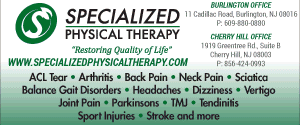
Though once considered taboo, alternative medicine practices have become widely accepted.
From the use of acupuncture to relieve arthritis pain to chiropractic techniques for back and neck problems to drinking green tea for flu prevention, complementary and alternative medicine (CAM) therapies are becoming more widely accepted by not only the general population but also among professionals in mainstream medicine. That certainly wasn’t always the case. There was a time when these less conventional therapies were considered taboo. Patients might have once felt uncomfortable mentioning the idea to their doctor. But today, many primary care physicians are the first to refer patients to CAM practitioners and may even be patients themselves.
Moving mainstream
Dr. Michael J. O’Keefe, of O’Keefe Chiropractic Center P.A. in Medford, says he has doctor-patients who practice medicine in almost every field. Cardiologists, gastroenterologists, OB/GYNs, family doctors and other medical practitioners are just some of his regular chiropractic patients. O’Keefe says this fact alone shows how far the field has come. “I think one of the biggest reasons alternative and more traditional medicine are coming together is the research,” he says. “There is so much more research supporting methods outside of conventional medicine and those science-based facts are drawing more into the field. I’m finding that things like chiropractic, once considered alternative, are now becoming more mainstream. That’s why in my own practice I’m not only getting more physicians referring me to their patients but I’m getting the physicians themselves as my patients.”
Dr. Jesse Liebman, of the Liebman Wellness Center in Marlton, says he too sees physicians as patients. He attributes the increasing interest in “alternative practices” to a changing health care paradigm. “Our society is moving away from a sickness care model where you don’t think about health until you’re sick,” Liebman explains. “Now we’re moving toward wellness care which is all about preventing sickness in the first place. That’s why these kinds of treatments are becoming more mainstream.”
As the public demands more of these options, and physicians get on board with recommending them, the two fields are beginning to collide. Now the term “integrative medicine” is used as a means of describing a practice that involves elements of both fields. These two modalities can certainly work together.
“Today, almost every major institution has a complementary or integrative medicine department,” says Dr. Polina Karmazin, medical director of Integrative Medicine at Virtua. “Education has played a large role in it becoming more popular in the United States. People are seeing that these practices have results and they’re becoming more accepting and trying it for themselves.”
A number of options
Karmazin is partial to acupuncture and homeopathy as she has been practicing them herself for years. Acupuncture is a complementary medical practice that involves stimulating anatomical points on the skin with needles or electrical stimulation. Homeopathy is a system of medicine that involves treating the patient with highly diluted substances in order to trigger the body’s natural system of healing. “Both areas have been proven safe and effective for many centuries,” Karmazin says. “I gravitate toward methods that have been proven and supported by the National Institutes of Health (NIH) and the U.S. Food and Drug Administration (FDA).”
There is also massage, Reiki, Tai Chi and many other forms of CAM that patients might find effective in treating various ailments or issues. A big key to these treatments is that they look at the whole body and person, says Liebman. Complementary practices recognize that elements such as a person’s emotional and spiritual well-being also have an effect on their health, he says. As a result, mental health treatments have also been increasingly accepted as our understanding evolves.
“As times change and our knowledge base increases, we find that a lot of evidence-based treatments are not in line with the traditional medical model of treating all ailments with pharmaceuticals,” says psychologist Dr. David Leibovitz, of the Hopewell Springs Counseling Center, LLC in Cherry Hill. Leibovitz says the field of psychology is built on the fact that behavioral interventions and psychotherapies can be incredibly effective at treating all kinds of issues including anxiety, depression and even physical symptoms that arise. Drugs should never be the first answer.
“Cognitive behavioral therapy, which is a type of evidence-based psychotherapy, has been really effective at treating symptoms of things like panic attacks, OCD, generalized anxiety and depression,” Leibovitz says. “It’s been around for thousands of years but only recently has been recognized by the literature as an effective skill.” That’s true of many of these modalities. Liebman adds that chiropractic is nothing new, either. Acupuncture began in China more than 4,000 years ago. And massage may date back more than 5,000 years. Karmazin says these treatments may seem new to many—but they’ve been around for quite some time.
“Acupuncture dates back 4,000 years ago, but it’s actually been in America longer than many realize as well—about 200 years,” she says. “In 1976, the FDA declared the acupuncture needle a medical device and the NIH has since published evidence of its effectiveness. In addition, homeopathy has been around since the 1790s and has been FDA regulated since 1938. While the field of integrated medicine is quite broad and there are a number of modalities, I feel like it makes sense to pursue treatments that have been proven by both time and research.”
Side-effect free
When facing an ailment or concern, it always makes sense to try a side-effect-free solution first. Liebman says taking medication—especially long term—can have a number of downsides such as possible drug-related reactions and side effects. A drug-free solution such as chiropractic is worth trying. “Medicine has a place and can have some life-saving effects—and some people really need it,” admits Liebman. “But the problem is that the side effects can also kill people. If you can find a drug-free treatment that solves your problem, why wouldn’t you try that first?”
Still, that’s not to say a practitioner would ignore an issue that requires traditional medical attention. “Proper diagnosis is so important,” adds O’Keefe. “I treat many patients who have headaches due to neck or vertical spine problems. But I’ve also treated a patient whose medical history led me to believe he might have something else going on, and an MRI found a brain tumor. It’s important for us to make a diagnosis since there are those patients who come to me and end up needing medical attention, not chiropractic attention. So the first step is diagnosis. The next step is starting with the most conservative approach possible for your problem.”
Karmazin says she continues to see a future where the worlds of conventional medicine and complementary practices work together. Alternative practices are not meant to be a replacement. “Many physicians like me are also practicing forms of complementary medicine,” Karmazin says. “As the term suggests, it can complement conventional practices or, in some cases, even eliminate the need for conventional treatment like medication. Just bear in mind that whatever treatments you pursue, you should always keep your doctor informed.”
Published (and copyrighted) in South Jersey Magazine, Volume 11, Issue 2 May, 2014).
For more info on South Jersey Magazine, click here.
To subscribe to South Jersey Magazine, click here.
To advertise in South Jersey Magazine, click here.












